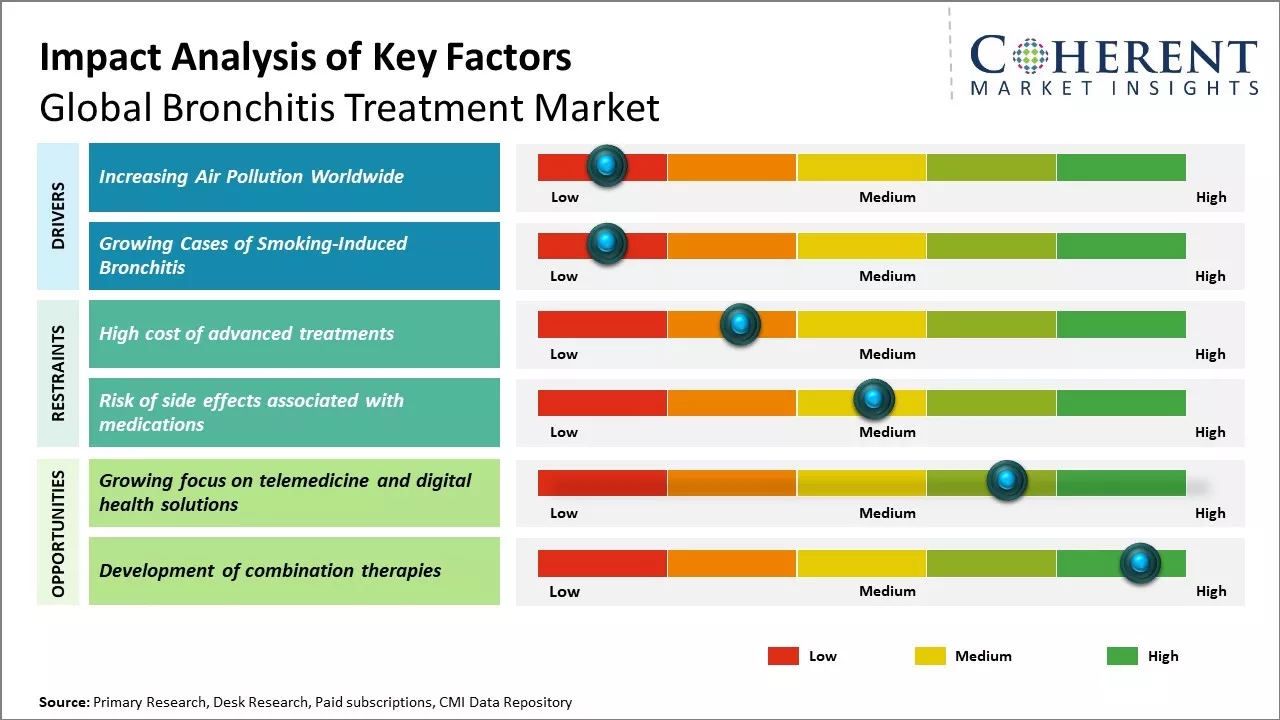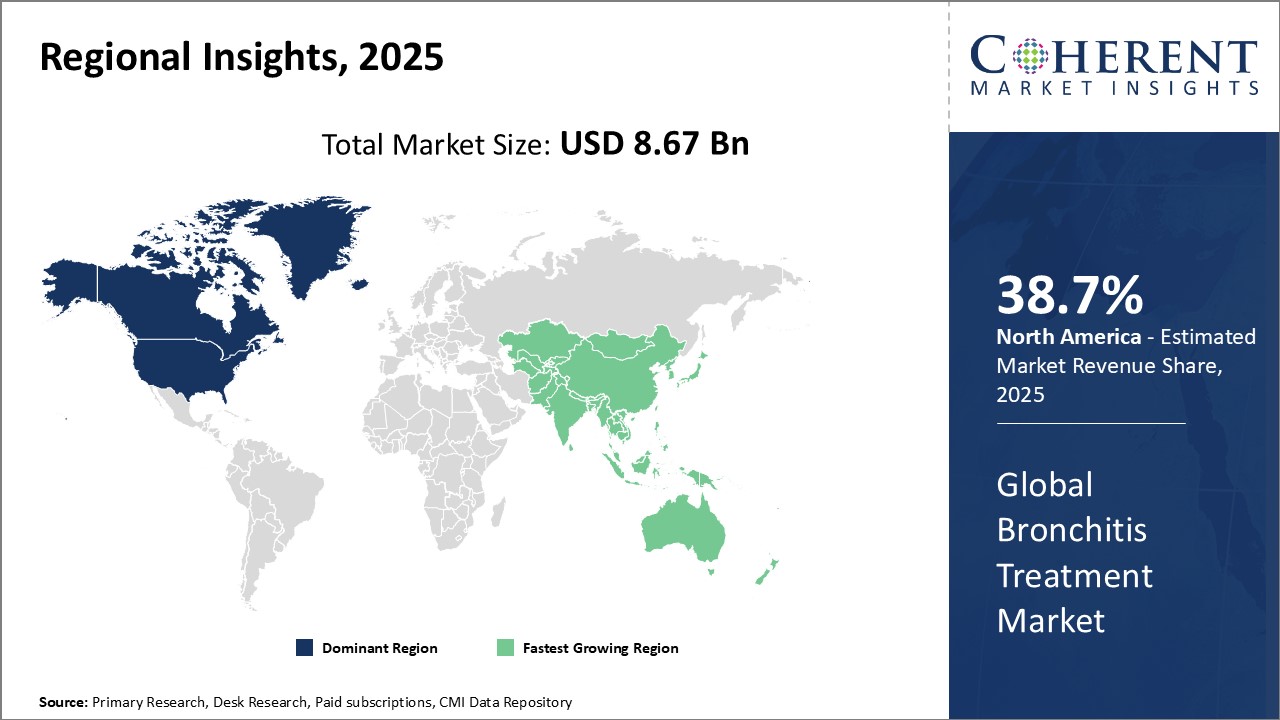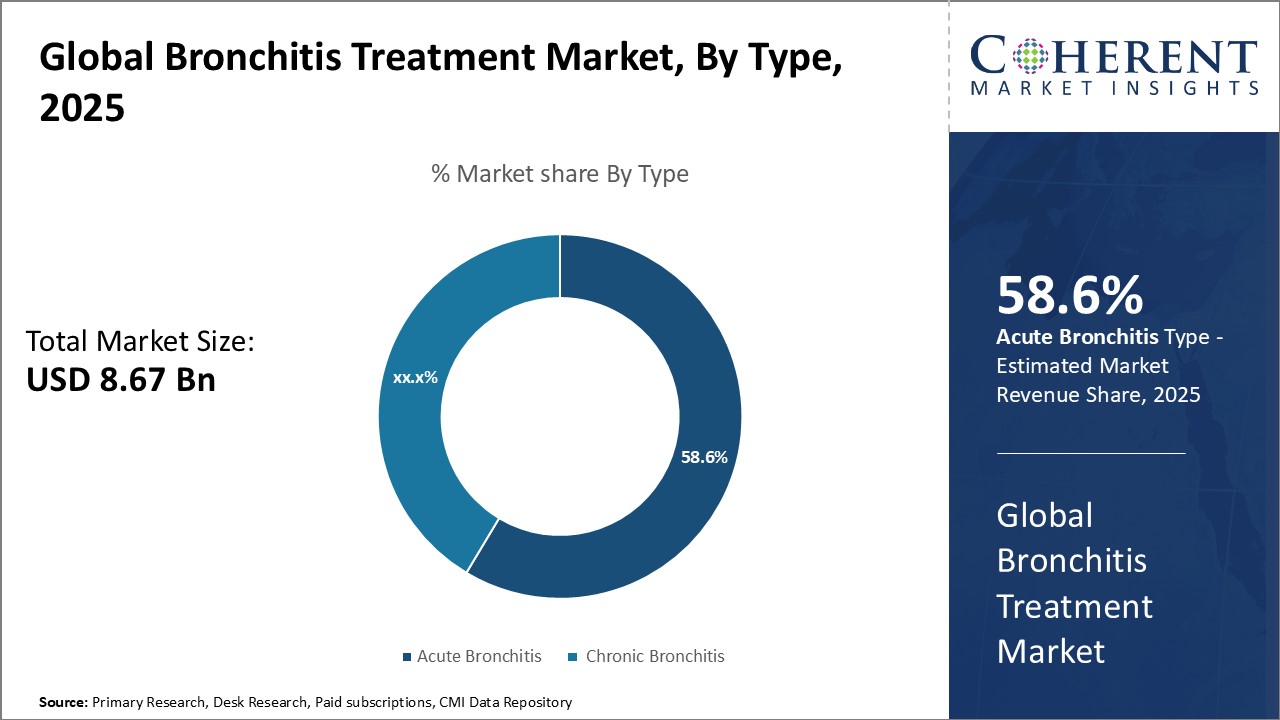Bronchitis Treatment Market Size and Forecast – 2025-2032
Global bronchitis treatment market is estimated to be valued at USD 8.67 Bn in 2025 and is expected to reach USD 12.62 Bn by 2032, exhibiting a compound annual growth rate (CAGR) of 5.5% from 2025 to 2032.

To learn more about this report, Download Free Sample
Key Takeaways of the Global Bronchitis Treatment Market
- Based on Type, Acute Bronchitis Division will dominate the market in 2025 with 58.6 % share. This is because of rising incidence and shorter duration of treatment compared to chronic bronchitis.
- By Drug Class, Anti-Inflammatory Drugs Segment is expected to have the highest market share. This is because of factors like extensive use in COPD.
- The North American market is projected to hold a commanding market share of 38.7% by 2025. This would be based on highly established health infrastructure, significant drug availability, and good reimbursement policies.
Market Overview
Global bronchitis treatment market will experience a constant growth trend during the forecast period, on account of rising respiratory conditions all over the world as a result of increased pollution rates and a lifestyle change. Heavy smoking is also well-accepted as being among the main causative factors for acute and chronic bronchitis. Increased pollution rates in urban regions have played a major role in elevating respiratory conditions. Additionally, advancements in technology have resulted in recent years in new product launches. New drugs and devices are coming out for successful treatment of bronchitis. Nonetheless, poor awareness of bronchitis in a few developing countries can slow down the market growth in the near future.
For instance, In 2024, the Bureau of Labor Statistics reported an increase in respiratory diseases among American w4orkers, up from 27.8 cases per 10,000 FTE workers in 2021 to 35.8 cases in 2022. The increase is due to increased exposure to respiratory hazards, and the need for good bronchitis treatments becomes paramount.
Current Events and Its Impact on Bronchitis Treatment Market
|
Current Events |
Description and its impact |
|
Integration of Advanced Drug Delivery Systems |
|
|
Growing Focus on Smoking Cessation Programs |
|
Uncover macros and micros vetted on 75+ parameters: Get instant access to report
Market Concentration and Competitive Landscape

To learn more about this report, Download Free Sample
Bronchitis Treatment Market Driver
- Growing Cases of Smoking-Induced Bronchitis
The worldwide market for the management of bronchitis is expanding with the increase in the number of cases of smoking-induced bronchitis. The primary cause of both chronic and acute bronchitis is smoking, because it damages cilia lining inside bronchial tubes, so they are not able to expel mucus and foreign substances from lungs. This results in inflammation and filling of bronchial tubes with mucus. Chronic bronchitis, typically linked with chronic smoking, is characterized by a chronic cough with sputum production for at least three months in two consecutive years. Studies have proven that about 90% of chronic bronchitis is triggered by smoking. World Health Organization (WHO) reveal that more than 70% of COPD in developed countries and 30–40% in low- and middle-income countries are due to tobacco smoking. With approximately 1.3 billion tobacco users worldwide, the majority residing in low- and middle-income nations, the burden of COPD will swell in the forthcoming decades.
- Rising air pollution
Rising air pollution is driving the worldwide market for treating bronchitis strongly. Air pollution resulted in 8.1 million deaths globally in 2021, as per the State of Global Air 2024 report, and is the second highest risk factor for mortality, including among children under the age of five. Long-term exposure to polluted air damages the lungs, leading to chronic respiratory disease like bronchitis, which leads to cough, wheezing, and shortness of breath. Urbanization, global warming, and elevated levels of pollutants are all responsible for the rise in bronchitis incidence. This has led to a growing demand for bronchitis diagnostics and treatments, including combination therapy with corticosteroids, antibiotics, and bronchodilators.
Market Challenge
Overpricing of Sophisticated Treatments
The high cost of advanced bronchitis treatments is a major challenge to the global market of bronchitis treatment. Whereas acute bronchitis is treated with generic medicines that can be bought from general stores without any prescription, chronic bronchitis is managed with expensive medicines such as bronchodilators, steroids, antibiotics, and oxygen therapy. They are out of reach of individuals in the low to middle income groups as there are more than 40% of the populations in the whole world who are living on a daily income of less than US$ 5.50. Costly treatments also discourage adherence to prescribed therapies, leading to worsened symptoms and increased future healthcare expenditures. Studies have shown that nearly 50% of U.S. chronic bronchitis patients fail to continue medication due to cost.
Market Opportunity
Growing Interest in Telemedicine and Digital Health Solutions
The worldwide market for the treatment of bronchitis has immense growth opportunities as the demand for telemedicine and digital health technologies is increasing. Many healthcare systems have enhanced telemedicine infrastructure, and the European Commission has invested over €200 million to develop virtual care in the EU. In the US, expansion of telehealth coverage resulted in a 154% rise in telehealth usage between 2019 and 2020. This shift opens the possibility of bronchitis management by remote monitoring, drug therapy, and personalized care.
By Type- Increasing incidence of air pollution fuels acute bronchitis segment growth
Based on type, acute bronchitis segment is projected to hold the largest market share of, due to factors like increasing incidence of air pollution across the world. Acute Bronchitis is induced by viral or bacterial infections and progresses quickly over a short duration, typically preceded by a cold or the flu. The illness is also the result of the lower respiratory tract attempting to fight off infection. In most regions of the world, air pollution has increased drastically over the last several decades as a consequence of accelerated industrialization and urbanization. Chronic exposure to traffic emissions, cigarette smoke and other outside pollutants compromises the immune system and destroys the cilia lining the lower respiratory system, leaving individuals vulnerable to acute bronchitis. Areas experiencing heavy smog or high particulate matter concentration are likely to report a higher rate of acute bronchitis. This increases demand for therapies and drugs for treating exacerbation of the disease. Inadequate pollution control in developing countries also adds to increasing acute bronchitis patient base worldwide.
By Treatment- Oral medication popularity drives drugs segment growth
Drugs segment, by treatment, is estimated to hold the maximum market share of, driven by factors like oral medication popularity and convenience for bronchitis. Though oxygen therapy relieves breathlessness immediately, medications remain the most effective long-term treatment approach to both acute and chronic bronchitis. Numerous antibiotics, cough suppressants, expectorants and anti-inflammatory medications come in oral pill or liquid form and are thus extremely convenient to stick to as compared to nebulizers or inhalers. Treatment guidelines also prefer a course of medication prior to other treatments. The oral route has less expensive choices as well. This has maintained that drugs remain the first defense against the greater number of patients of bronchitis.
By Drug Class- Anti-inflammatory drugs segment growth powered by widespread usage in COPD treatment
With regards to drug class, the anti-inflammatory drugs segment is anticipated to hold the greatest market share of, on account of parameters such as its prevalent usage within COPD treatment regimes. Chronic bronchitis very often accompanies emphysema in COPD patients. Ongoing inflammation in the lower respiratory tract is a common feature of both conditions. Consequently, anti-inflammatory medications play a crucial role in chronic management of symptoms of chronic bronchitis. Multiple corticosteroids and other new anti-inflammatory compounds are used routinely to suppress symptoms and soften flares. Considering the widespread prevalence of COPD all over the world, these drugs are consumed on a massive scale. Some anti-inflammatory drugs also reduce recovery from acute bronchitis attacks by suppressing the inflammatory response. Such widespread, multi-functional use of anti-inflammatory drugs has contributed to increasing their intake.
Regional Insights

To learn more about this report, Download Free Sample
North America Bronchitis Treatment Market Analysis and Trends
North America leads the global market for the treatment of bronchitis with an estimated 38.7% market share in 2025. Owing to the presence of top pharma companies and sophisticated healthcare facilities, North America has high availability of quality bronchitis medications and medical equipment. North America has a preventive healthcare culture and increasing health consciousness among the population that fuel early treatment-seeking behavior for lung ailments such as bronchitis.
Strict regulatory principles guarantee highest quality standards are adhered to by drug developers prior to their approval and marketing in the continent. This has built customers' confidence in indigenous bronchitis products over decades. Additionally, private health insurance availability and favorable reimbursement policy ensure high availability of treatments in North America. Major medical device manufacturers in the U.S. and Canada also provide a large variety for bronchitis pulmonary therapy with varied costs.
Asia Pacific Bronchitis Treatment Market Analysis and Trends
Asia Pacific region is showing the highest growing bronchitis treatment market. China and India are seeing economic growth and better access to healthcare. Disposable incomes are rising, enabling customers to spend increasingly on respiratory disease treatment. Additionally, governments are concentrating on improving healthcare infrastructure in rural areas. This draws a lot of global pharmaceutical firms to either establish local production facilities or form strategic alliances with local drug manufacturers for bronchitis drugs. Growing awareness regarding lifestyle diseases and advantages of early treatment propel the market growth.
Dominating Countries in Bronchitis Treatment Market
United States Bronchitis Treatment Market Analysis and Trends
The United States is the front runner in the world market for the treatment of bronchitis, as it has a developed infrastructure in the healthcare sector, high healthcare expenditure, and universal adoption of medical technologies. The huge number of people suffering from chronic bronchitis due to smoking culture and an enormous number of people suffering from respiratory diseases fuel the demand for these treatments in the form of bronchodilators, corticosteroids, and antibiotics.
China Bronchitis Treatment Market Analysis and Trends
China is one of the largest markets for the treatment of bronchitis, depending on the rising level of air pollution in the country, the level of smoking, and the number of elderly people who are prone to chronic respiratory diseases. The government's healthcare access initiatives and the rising awareness of lung diseases have increased demand for the treatment of bronchitis, medication, and therapy.
India Bronchitis Treatment Market Analysis and Trends
The market for bronchitis treatment in India is expanding due to an increasing rate of respiratory diseases owing to air pollution, smoking, and increasing urbanization. Since chronic respiratory disease has a very high prevalence in urban cities, which have low-quality air, the demand for good treatments for bronchitis is increasing at a rapid rate. The fact that the government has focused more on building health infrastructure as well as increasing the awareness regarding respiratory health also facilitates the Indian market.
United Kingdom Bronchitis Treatment Market Analysis and Trends
Treatment for bronchitis in the United Kingdom is being driven by a combination of the aging population and an increased rate of smoking-related respiratory diseases. United Kingdom healthcare infrastructure, supported by the NHS, provides wide coverage of treatments for bronchitis. Increased rates of respiratory diseases and the evolution of treatment solutions such as combination drugs and inhalers are driving the market in the region.
Market Report Scope
Global Bronchitis Treatment Market Report Coverage
| Report Coverage | Details | ||
|---|---|---|---|
| Base Year: | 2024 | Market Size in 2025: | USD 8.67 Bn |
| Historical Data for: | 2020 To 2024 | Forecast Period: | 2025 To 2032 |
| Forecast Period 2025 to 2032 CAGR: | 5.5% | 2032 Value Projection: | USD 12.62 Bn |
| Geographies covered: |
|
||
| Segments covered: |
|
||
| Companies covered: |
GlaxoSmithKline, AstraZeneca, Boehringer Ingelheim, Novartis, Merck & Co., Pfizer, Teva Pharmaceutical Industries, Sanofi, Roche, Johnson & Johnson, Mylan N.V., Gilead Sciences, AbbVie, Bausch Health Companies, Hikma Pharmaceuticals, Amgen, Sumitomo Dainippon Pharma, Eli Lilly and Company |
||
| Growth Drivers: |
|
||
| Restraints & Challenges: |
|
||
Uncover macros and micros vetted on 75+ parameters: Get instant access to report
Global Bronchitis Treatment Industry News
- In July 2024, CSA Medical Inc., the developer of The RejuvenAir System utilizing liquid nitrogen spray cryotherapy, had completed patient enrolment in its SPRAY-CB pivotal trial. This double-blind, sham-controlled clinical trial enrolled 210 patients globally for the treatment of COPD with Chronic Bronchitis.
- In June 2024, the U.S. FDA approved Ohtuvayre (ensifentrine), the first new inhaled medicine for chronic obstructive pulmonary disease (COPD) in more than two decades. This drug has the combined effects of phosphodiesterase 3 and 4 inhibitors, providing bronchodilation and anti-inflammatory activity. Clinical trials showed a 40% decrease in flare-ups and enhanced lung function without the typical side effects of corticosteroids and conventional bronchodilators.
Key Takeaways from Analyst
- The global bronchitis treatment market is fueled by an increasing geriatric population that is more susceptible to chronic respiratory disorders like bronchitis. Increasing level of pollution coupled with lifestyle changes and rising prevalence of smoking also help drive the increasing numbers of acute cases of bronchitis worldwide. Innovation in drug delivery systems and new combination therapy can offer emerging opportunities for the market participants.
- Limited availability of disease-specific medications and heavy dependence on generic drugs to manage bronchitis symptoms can impede the growth of the market. Compliance with medication and changes in lifestyle after treatment can also be challenging.
- By region, the market will be led by developed economies as they have better awareness and spending on healthcare. In contrast, developing Asian nations will constitute the most profitable market region due to their huge patient base and enhancing access to healthcare. Treatment scenario of bronchitis will change with more emphasis on prevention of exacerbations and treating the underlying causes. Telehealth and remote monitoring solutions have the potential to enhance medication compliance. Additional research into pathogenic mechanisms and new drugs with different indications for different diseases can propel the market growth.
Market Segmentation
- Type Insights (Revenue, USD Bn, 2020 - 2032)
- Acute Bronchitis
- Chronic Bronchitis
- Treatment Insights (Revenue, USD Bn, 2020 - 2032)
- Drugs
- Oxygen Therapy
- Drug Class Insights (Revenue, USD Bn, 2020 - 2032)
- Anti-Inflammatory Drugs
- Antibiotics
- Bronchodilators
- Mucolytic
- Route of Administration Insights (Revenue, USD Bn, 2020 - 2032)
- Oral
- Parenteral
- Inhalers/Nasal sprays
- Others
- Distribution Channel Insights (Revenue, USD Bn, 2020 - 2032)
- Online Pharmacies
- Retail Pharmacies
- Hospital Pharmacies
- Regional Insights (Revenue, USD Bn, 2020 - 2032)
- North America
- U.S.
- Canada
- Latin America
- Brazil
- Argentina
- Mexico
- Rest of Latin America
- Europe
- Germany
- U.K.
- Spain
- France
- Italy
- Russia
- Rest of Europe
- Asia Pacific
- China
- India
- Japan
- Australia
- South Korea
- ASEAN
- Rest of Asia Pacific
- Middle East
- GCC Countries
- Israel
- Rest of Middle East
- Africa
- South Africa
- North Africa
- Central Africa
- Key Players Insights
- GlaxoSmithKline
- AstraZeneca
- Boehringer Ingelheim
- Novartis
- Merck & Co.
- Pfizer
- Teva Pharmaceutical Industries
- Sanofi
- Roche
- Johnson & Johnson
- Mylan N.V.
- Gilead Sciences
- AbbVie
- Bausch Health Companies
- Hikma Pharmaceuticals
- Amgen
- Sumitomo Dainippon Pharma
- Eli Lilly and Company
Sources
Primary Research Interviews
- Pharmaceutical Industry Executives
- Healthcare Providers/Pulmonologists
- Medical Researchers/Academics
- Regulatory Authorities (e.g., FDA, EMA)
- Others
Databases
- Transparency Market Research Bronchitis Treatment Database
- Verified Market Research Acute Bronchitis Treatment Analytics
- Grand View Research Respiratory Therapeutics Repository
- Others
Magazines
- Pharmaceutical Executive
- Medical News Today
- Healthcare Business Review
- Others
Journals
- The Lancet Respiratory Medicine
- Chest Journal
- European Respiratory Journal
- Others
Newspapers
- The Wall Street Journal (Healthcare Sector)
- Financial Times (Pharmaceuticals Section)
- STAT News
- Others
Associations
- American Lung Association
- Global Initiative for Chronic Obstructive Lung Disease (GOLD)
- European Respiratory Society
- Others
Public Domain Sources
- World Health Organization (WHO) Respiratory Disease Reports
- Centers for Disease Control and Prevention (CDC) Bronchitis Guidelines
- National Institutes of Health (NIH) Clinical Trials Database
- Others
Proprietary Elements
- CMI Data Analytics Tool
- Proprietary CMI Existing Repository of Information for Last 8 Years
* Definition: Global Bronchitis Treatment Market involves developing and providing drugs, medical devices, vaccines and other treatment options for acute and chronic bronchitis on a global scale. Key players in this market focus on research and development of new therapies and medications to treat symptoms, prevent exacerbations, and improve quality of life for patients suffering from both forms of this inflammatory lung disease worldwide. The goal is to expand treatment accessibility and clinical efficacy through international research, clinical trials, manufacturing, and distribution of bronchitis treatments.
Share
Share
About Author
Ghanshyam Shrivastava - With over 20 years of experience in the management consulting and research, Ghanshyam Shrivastava serves as a Principal Consultant, bringing extensive expertise in biologics and biosimilars. His primary expertise lies in areas such as market entry and expansion strategy, competitive intelligence, and strategic transformation across diversified portfolio of various drugs used for different therapeutic category and APIs. He excels at identifying key challenges faced by clients and providing robust solutions to enhance their strategic decision-making capabilities. His comprehensive understanding of the market ensures valuable contributions to research reports and business decisions.
Ghanshyam is a sought-after speaker at industry conferences and contributes to various publications on pharma industry.
Missing comfort of reading report in your local language? Find your preferred language :
Transform your Strategy with Exclusive Trending Reports :
Frequently Asked Questions
EXISTING CLIENTELE
Joining thousands of companies around the world committed to making the Excellent Business Solutions.
View All Our Clients

